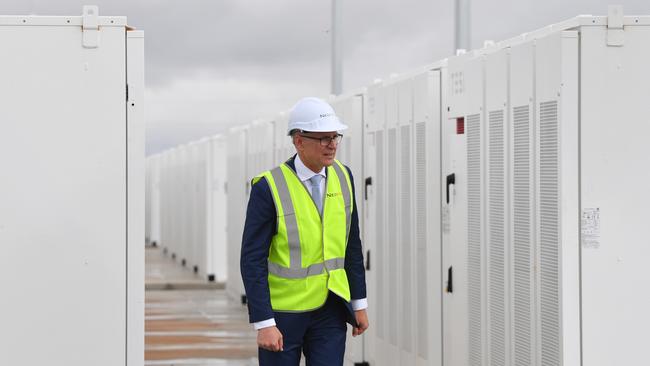South Australia’s big Tesla battery fires up for summer
It’s the moment of truth for Elon Musk’s giant lithium-ion battery system. Will it help protect against blackouts this summer?

It’s the moment of truth for Tesla and the South Australian government with Elon Musk’s giant lithium-ion battery system now online in the state.
Premier Jay Weatherill officially flicked the switch at Jamestown in the state’s mid-north today, saying it was history in the making.
“I want to express my gratitude to the workers who have constructed this battery, they have every right to be proud of what they have constructed,” Mr Weatherill said.
Will the Tesla system help protect South Australia against blackouts in the upcoming summer storm season, or will its output prove insufficient? That’s the burning question.
Tesla won the contract to build the battery system in July.
The lithium-ion battery system is designed to store excess power generated from wind energy for later use.
It is designed to store 129 megawatt hours (MWh) of power for use at times of acute shortage. That’s apparently enough to power 30,000 homes for more than an hour. If the outage is shorter, say 5 minutes, that equates to 360,000 or more. (Tesla regards these housing figures only as a guide.) The maximum throughput is 100MW.
The battery has gone online right at the start of summer, a period where there is a higher probability of destructive storm weather in SA.
The Tesla system has faced criticisms: its experimental nature, the unknown cost, and the issue of capacity.
Mr Musk’s cousin Lyndon Rive this year told The Australian that the battery system would successfully fill the void.
He said it was more cost effective for taxpayers to opt for storage than to upgrade transmission lines. “The only reason we are building more transmission lines is to address congestion that may happen a few times a year.”
Tesla’s hopes of the SA system succeeding stems from its experience in California, where it built a 20MW, 80MWh plant consisting of 386 Powerwall 2 batteries which it says can power about 15,000 homes for four hours daily.
Elon Musk promised to supply the batteries within 100 days of signing off on all the contract details. While Tesla managed to supply the SA government with the batteries on time, industry sources have told The Australian there has been production shortages of its Powerwall batteries which has led to a delay in consumer installations.
Known as the Hornsdale Power Reserve, the battery system was launched by Mr Weatherill and French renewable energy company Neoen’s deputy CEO Romain Desrousseaux.
It connects to Neoen’s Hornsdale wind farm.
A news release issued by the SA government today says the ability to dispatch into the system when needed will allow the Hornsdale Power Reserve to sign competitive long term contracts with medium-sized business.
Today’s launch follows regulatory testing of the battery’s ability to charge to and from the National Energy Market.
The SA Government announced the plan to use a renewable energy source in March and both Tesla and Neoen were awarded contracts in July.
Premier Jay Weatherill in a statement says South Australia is now leading the world in dispatchable renewable energy. “This is history in the making,” he says.
“I want to express my gratitude to the workers who have constructed this battery — they have every right to be proud of what they’ve constructed.”
Mr Desrousseaux says Neoen is pleased to reinforce its Australian footprint through the Hornsdale Wind Farm & Battery.
Tesla says it hopes the project provides a model for future deployments around the world.




To join the conversation, please log in. Don't have an account? Register
Join the conversation, you are commenting as Logout